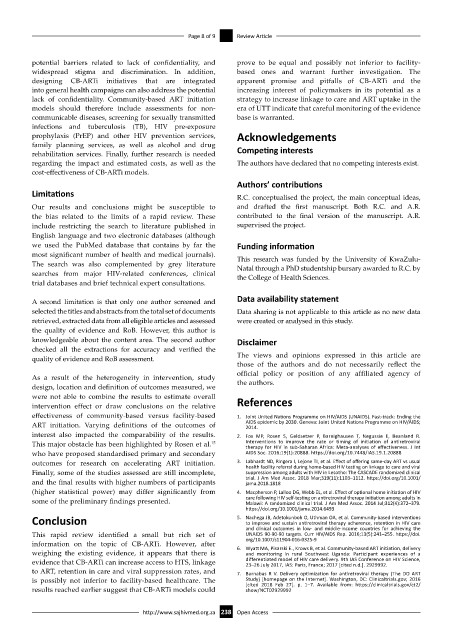Page 246 - HIVMED_v21_i1.indb
P. 246
Page 8 of 9 Review Article
potential barriers related to lack of confidentiality, and prove to be equal and possibly not inferior to facility-
widespread stigma and discrimination. In addition, based ones and warrant further investigation. The
designing CB-ARTi initiatives that are integrated apparent promise and pitfalls of CB-ARTi and the
into general health campaigns can also address the potential increasing interest of policymakers in its potential as a
lack of confidentiality. Community-based ART initiation strategy to increase linkage to care and ART uptake in the
models should therefore include assessments for non- era of UTT indicate that careful monitoring of the evidence
communicable diseases, screening for sexually transmitted base is warranted.
infections and tuberculosis (TB), HIV pre-exposure
prophylaxis (PrEP) and other HIV prevention services, Acknowledgements
family planning services, as well as alcohol and drug
rehabilitation services. Finally, further research is needed Competing interests
regarding the impact and estimated costs, as well as the The authors have declared that no competing interests exist.
cost-effectiveness of CB-ARTi models.
Authors’ contributions
Limitations R.C. conceptualised the project, the main conceptual ideas,
Our results and conclusions might be susceptible to and drafted the first manuscript. Both R.C. and A.R.
the bias related to the limits of a rapid review. These contributed to the final version of the manuscript. A.R.
include restricting the search to literature published in supervised the project.
English language and two electronic databases (although
we used the PubMed database that contains by far the Funding information
most significant number of health and medical journals). This research was funded by the University of KwaZulu-
The search was also complemented by grey literature Natal through a PhD studentship bursary awarded to R.C. by
searches from major HIV-related conferences, clinical the College of Health Sciences.
trial databases and brief technical expert consultations.
Data availability statement
A second limitation is that only one author screened and
selected the titles and abstracts from the total set of documents Data sharing is not applicable to this article as no new data
retrieved, extracted data from all eligible articles and assessed were created or analysed in this study.
the quality of evidence and RoB. However, this author is
knowledgeable about the content area. The second author Disclaimer
checked all the extractions for accuracy and verified the
quality of evidence and RoB assessment. The views and opinions expressed in this article are
those of the authors and do not necessarily reflect the
official policy or position of any affiliated agency of
As a result of the heterogeneity in intervention, study
design, location and definition of outcomes measured, we the authors.
were not able to combine the results to estimate overall
intervention effect or draw conclusions on the relative References
effectiveness of community-based versus facility-based 1. Joint United Nations Programme on HIV/AIDS (UNAIDS). Fast-track: Ending the
ART initiation. Varying definitions of the outcomes of AIDS epidemic by 2030. Geneva: Joint United Nations Programme on HIV/AIDS;
2014.
interest also impacted the comparability of the results. 2. Fox MP, Rosen S, Geldsetzer P, Barnighausen T, Negussie E, Beanland R.
This major obstacle has been highlighted by Rosen et al. 15 Interventions to improve the rate or timing of initiation of antiretroviral
therapy for HIV in sub-Saharan Africa: Meta-analyses of effectiveness. J Int
who have proposed standardised primary and secondary AIDS Soc. 2016;19(1):20888. https://doi.org/10.7448/IAS.19.1.20888
outcomes for research on accelerating ART initiation. 3. Labhardt ND, Ringera I, Lejone TI, et al. Effect of offering same-day ART vs usual
health facility referral during home-based HIV testing on linkage to care and viral
Finally, some of the studies assessed are still incomplete, suppression among adults with HIV in Lesotho: The CASCADE randomized clinical
trial. J Am Med Assoc. 2018 Mar;319(11):1103–1112. https://doi.org/10.1001/
and the final results with higher numbers of participants jama.2018.1818
(higher statistical power) may differ significantly from 4. Macpherson P, Lalloo DG, Webb EL, et al. Effect of optional home initiation of HIV
care following HIV self-testing on antiretroviral therapy initiation among adults in
some of the preliminary findings presented. Malawi: A randomized clinical trial. J Am Med Assoc. 2014 Jul;312(4):372–379.
https://doi.org/10.1001/jama.2014.6493
Conclusion 5. Nachega JB, Adetokunboh O, Uthman OA, et al. Community-based interventions
to improve and sustain antiretroviral therapy adherence, retention in HIV care
and clinical outcomes in low- and middle-income countries for achieving the
This rapid review identified a small but rich set of UNAIDS 90-90-90 targets. Curr HIV/AIDS Rep. 2016;13(5):241–255. https://doi.
org/10.1007/s11904-016-0325-9
information on the topic of CB-ARTi. However, after 6. Wyatt MA, Pisarski E., Krows B, et al. Community-based ART initiation, delivery
weighing the existing evidence, it appears that there is and monitoring in rural Southwest Uganda: Participant experiences of a
evidence that CB-ARTi can increase access to HTS, linkage differentiated model of HIV care delivery. 9th IAS Conference on HIV Science,
23–26 July 2017, IAS: Paris, France; 2017 [cited n.d.]. 2929992.
to ART, retention in care and viral suppression rates, and 7. Barnabas R V. Delivery optimization for antiretroviral therapy (The DO ART
is possibly not inferior to facility-based healthcare. The Study) [homepage on the Internet]. Washington, DC: Clinicaltrials.gov; 2016
[cited 2018 Feb 27]. p. 1–7. Available from: https://clinicaltrials.gov/ct2/
results reached earlier suggest that CB-ARTi models could show/NCT02929992
http://www.sajhivmed.org.za 238 Open Access

